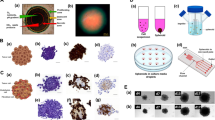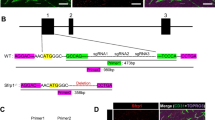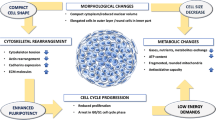Abstract
Little information is available concerning multidrug resistance (MDR) in mesenchymal stem cells, although several studies have reported that MDR is associated with hyaluronan in neoplastic cells. We have evaluated whether a hyaluronan-coated surface modulates MDR in placenta-derived human mesenchymal stem cells (PDMSCs). We have found that PDMSCs cultured on a tissue-culture polystyrene surface coated with 30 μg/cm2 hyaluronan are more resistant than control PDMSCs to doxorubicin. Inhibiting PI3K/Akt signaling has shown that the PI3K/Akt pathway modulates both P-glycoprotein activity and doxorubicin resistance. In addition, 10 μM verapamil dramatically suppresses the doxorubicin resistance induced by the hyaluronan-coated surface, indicating that P-glycoprotein activity is necessary for MDR. We have further found that PDMSCs treated with CD44 small interfering RNA (siRNA) and grown on a polystyrene surface coated with 30 μg/cm2 hyaluronan have fewer P-glycoprotein+ cells and lower CD44 expression levels (less than 60% in both cases) than PDMSCs not treated with CD44 siRNA and grown on the hyaluronan-coated surface. Moreover, treatment with CD44 siRNA suppresses the hyaluronan-substratum-induced doxorubicin resistance. We conclude that a hyaluronan substratum induces MDR in PDMSCs through CD44 signaling.






Similar content being viewed by others
References
Ambudkar SV, Dey S, Hrycyna CA, Ramachandra M, Pastan I, Gottesman MM (1999) Biochemical, cellular, and pharmacological aspects of the multidrug transporter. Annu Rev Pharmacol Toxicol 39:361–398
Arai F, Suda T (2007) Maintenance of quiescent hematopoietic stem cells in the osteoblastic niche. Ann N Y Acad Sci 1106:41–53
Barry FP, Murphy JM (2004) Mesenchymal stem cells: clinical applications and biological characterization. Int J Biochem Cell Biol 36:568–584
Bunting KD (2002) ABC transporters as phenotypic markers and functional regulators of stem cells. Stem Cells 20:11–20
Ceckova-Novotna M, Pavek P, Staud F (2006) P-glycoprotein in the placenta: expression, localization, regulation and function. Reprod Toxicol 22:400–410
Chaudhary PM, Roninson IB (1991) Expression and activity of P-glycoprotein, a multidrug efflux pump, in human hematopoietic stem cells. Cell 66:85–94
Colone M, Calcabrini A, Toccacieli L, Bozzuto G, Stringaro A, Gentile M, Cianfriglia M, Ciervo A, Caraglia M, Budillon A, Meo G, Arancia G, Molinari A (2008) The multidrug transporter P-glycoprotein: a mediator of melanoma invasion? J Invest Dermatol 128:957–971
Cordo-Russo RI, Garcia MG, Alaniz L, Blanco G, Alvarez E, Hajos SE (2008) Hyaluronan oligosaccharides sensitize lymphoma resistant cell lines to vincristine by modulating P-glycoprotein activity and PI3K/Akt pathway. Int J Cancer 122:1012–1018
Friedenstein AJ, Deriglasova UF, Kulagina NN, Panasuk AF, Rudakowa SF, Luria EA, Ruadkow IA (1974) Precursors for fibroblasts in different populations of hematopoietic cells as detected by the in vitro colony assay method. Exp Hematol 2:83–92
Fukuchi Y, Nakajima H, Sugiyama D, Hirose I, Kitamura T, Tsuji K (2004) Human placenta-derived cells have mesenchymal stem/progenitor cell potential. Stem Cells 22:649–658
Ghatak S, Misra S, Toole BP (2002) Hyaluronan oligosaccharides inhibit anchorage-independent growth of tumor cells by suppressing the phosphoinositide 3-kinase/Akt cell survival pathway. J Biol Chem 277:38013–38020
Ghatak S, Misra S, Toole BP (2005) Hyaluronan constitutively regulates ErbB2 phosphorylation and signaling complex formation in carcinoma cells. J Biol Chem 280:8875–8883
Gilg AG, Tye SL, Tolliver LB, Wheeler WG, Visconti RP, Duncan JD, Kostova FV, Bolds LN, Toole BP, Maria BL (2008) Targeting hyaluronan interactions in malignant gliomas and their drug-resistant multipotent progenitors. Clin Cancer Res 14:1804–1813
Gottesman MM, Fojo T, Bates SE (2002) Multidrug resistance in cancer: role of ATP-dependent transporters. Nat Rev Cancer 2:48–58
Han W, Yu Y, Liu XY (2006) Local signals in stem cell-based bone marrow regeneration. Cell Res 16:189–195
Hirao A, Arai F, Suda T (2004) Regulation of cell cycle in hematopoietic stem cells by the niche. Cell Cycle 3:1481–1483
Homolya L, Hollo Z, Germann UA, Pastan I, Gottesman MM, Sarkadi B (1993) Fluorescent cellular indicators are extruded by the multidrug resistance protein. J Biol Chem 268:21493–21496
Kim SG, Jeon CH, Suh HS, Choe JY, Shin IH (2007) P-glycoprotein expression in extracellular matrix formation of chondrogenic differentiation of human adult stem cells. Cell Biol Int 31:1042–1048
Laurent TC, Laurent UB, Fraser JR (1996) The structure and function of hyaluronan: an overview. Immunol Cell Biol 74:A1–A7
Lee WP (1993) The role of reduced growth rate in the development of drug resistance of HOB1 lymphoma cells to vincristine. Cancer Lett 73:105–111
Legrand O, Simonin G, Perrot JY, Zittoun R, Marie JP (1998) Pgp and MRP activities using calcein-AM are prognostic factors in adult acute myeloid leukemia patients. Blood 91:4480–4488
Lesley J, Hascall VC, Tammi M, Hyman R (2000) Hyaluronan binding by cell surface CD44. J Biol Chem 275:26967–26975
Liu CM, Chang CH, Yu CH, Hsu CC, Huang LL (2008) Hyaluronan substratum holds mesenchymal stem cells at slow cycling by prolonging the G1 phase. Cell Tissue Res 334:435–443
Marzioni D, Crescimanno C, Zaccheo D, Coppari R, Underhill CB, Castellucci M (2001) Hyaluronate and CD44 expression patterns in the human placenta throughout pregnancy. Eur J Histochem 45:131–140
Miletti-Gonzalez KE, Chen S, Muthukumaran N, Saglimbeni GN, Wu X, Yang J, Apolito K, Shih WJ, Hait WN, Rodriguez-Rodriguez L (2005) The CD44 receptor interacts with P-glycoprotein to promote cell migration and invasion in cancer. Cancer Res 65:6660–6667
Misra S, Ghatak S, Zoltan-Jones A, Toole BP (2003) Regulation of multidrug resistance in cancer cells by hyaluronan. J Biol Chem 278:25285–25288
Misra S, Ghatak S, Toole BP (2005) Regulation of MDR1 expression and drug resistance by a positive feedback loop involving hyaluronan, phosphoinositide 3-kinase, and ErbB2. J Biol Chem 280:20310–20315
Nakamura Y, Ikeda S, Furukawa T, Sumizawa T, Tani A, Akiyama S, Nagata Y (1997) Function of P-glycoprotein expressed in placenta and mole. Biochem Biophys Res Commun 235:849–853
Ohashi R, Takahashi F, Cui R, Yoshioka M, Gu T, Sasaki S, Tominaga S, Nishio K, Tanabe KK, Takahashi K (2007) Interaction between CD44 and hyaluronate induces chemoresistance in non-small cell lung cancer cell. Cancer Lett 252:225–234
Pavesio A, Renier D, Cassinelli C, Morra M (1997) Anti-adhesive surfaces through hyaluronan coatings. Med Device Technol 8:20–27
Pittenger MF, Mackay AM, Beck SC, Jaiswal RK, Douglas R, Mosca JD, Moorman MA, Simonetti DW, Craig S, Marshak DR (1999) Multilineage potential of adult human mesenchymal stem cells. Science 284:143–147
Prehm P, Schumacher U (2004) Inhibition of hyaluronan export from human fibroblasts by inhibitors of multidrug resistance transporters. Biochem Pharmacol 68:1401–1410
Schulz T, Schumacher U, Prehm P (2007) Hyaluronan export by the ABC transporter MRP5 and its modulation by intracellular cGMP. J Biol Chem 282:20999–21004
Shustik C, Dalton W, Gros P (1995) P-glycoprotein-mediated multidrug resistance in tumor cells: biochemistry, clinical relevance and modulation. Mol Aspects Med 16:1–78
Sugawara I, Kataoka I, Morishita Y, Hamada H, Tsuruo T, Itoyama S, Mori S (1988) Tissue distribution of P-glycoprotein encoded by a multidrug-resistant gene as revealed by a monoclonal antibody, MRK 16. Cancer Res 48:1926–1929
Tan B, Piwnica-Worms D, Ratner L (2000) Multidrug resistance transporters and modulation. Curr Opin Oncol 12:450–458
Toole BP (2004) Hyaluronan: from extracellular glue to pericellular cue. Nat Rev Cancer 4:528–539
Tsuruo T, Naito M, Tomida A, Fujita N, Mashima T, Sakamoto H, Haga N (2003) Molecular targeting therapy of cancer: drug resistance, apoptosis and survival signal. Cancer Sci 94:15–21
Wilson A, Oser GM, Jaworski M, Blanco-Bose WE, Laurenti E, Adolphe C, Essers MA, Macdonald HR, Trumpp A (2007) Dormant and self-renewing hematopoietic stem cells and their niches. Ann N Y Acad Sci 1106:64–75
Zhou S, Schuetz JD, Bunting KD, Colapietro AM, Sampath J, Morris JJ, Lagutina I, Grosveld GC, Osawa M, Nakauchi H, Sorrentino BP (2001) The ABC transporter Bcrp1/ABCG2 is expressed in a wide variety of stem cells and is a molecular determinant of the side-population phenotype. Nat Med 7:1028–1034
Zhu D, Bourguignon L (1996) Overexpression of CD44 in pl85(neu)-transfected NIH3T3 cells promotes an up-regulation of hyaluronic acid-mediated membrane-cytoskeleton interaction and cell adhesion. Oncogene 12:2309–2314
Author information
Authors and Affiliations
Corresponding author
Additional information
This work was supported by research grant NSC95–2745-B-006–003-MY2 from the National Science Council, Taiwan, and by Landmark Project Grant A25, funded by the Taiwan Ministry of Education, from National Cheng Kung University.
Rights and permissions
About this article
Cite this article
Liu, CM., Chang, CH., Yu, CH. et al. Hyaluronan substratum induces multidrug resistance in human mesenchymal stem cells via CD44 signaling. Cell Tissue Res 336, 465–475 (2009). https://doi.org/10.1007/s00441-009-0780-3
Received:
Accepted:
Published:
Issue Date:
DOI: https://doi.org/10.1007/s00441-009-0780-3




